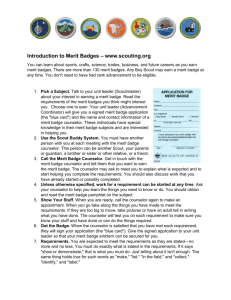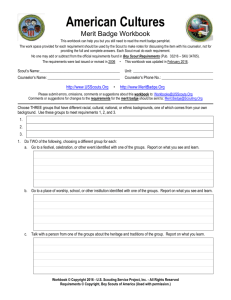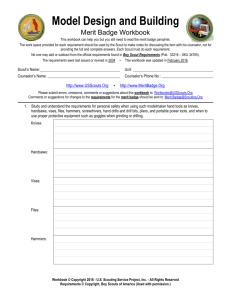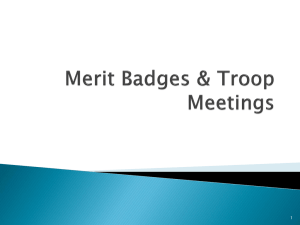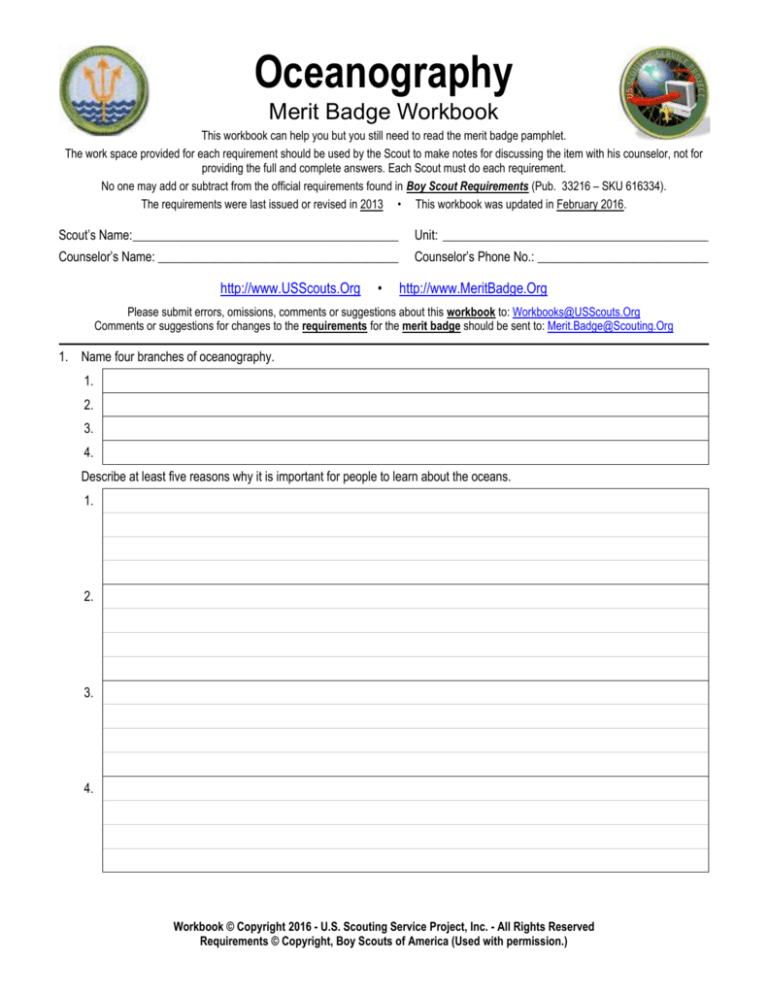
Oceanography
Merit Badge Workbook
This workbook can help you but you still need to read the merit badge pamphlet.
The work space provided for each requirement should be used by the Scout to make notes for discussing the item with his counselor, not for
providing the full and complete answers. Each Scout must do each requirement.
No one may add or subtract from the official requirements found in Boy Scout Requirements (Pub. 33216 – SKU 616334).
The requirements were last issued or revised in 2013 • This workbook was updated in February 2016.
Scout’s Name:__________________________________________
Unit: __________________________________________
Counselor’s Name: ______________________________________
Counselor’s Phone No.: ___________________________
http://www.USScouts.Org
•
http://www.MeritBadge.Org
Please submit errors, omissions, comments or suggestions about this workbook to: Workbooks@USScouts.Org
Comments or suggestions for changes to the requirements for the merit badge should be sent to: Merit.Badge@Scouting.Org
______________________________________________________________________________________________________________________________________________
1. Name four branches of oceanography.
1.
2.
3.
4.
Describe at least five reasons why it is important for people to learn about the oceans.
1.
2.
3.
4.
Workbook © Copyright 2016 - U.S. Scouting Service Project, Inc. - All Rights Reserved
Requirements © Copyright, Boy Scouts of America (Used with permission.)
Oceanography
Scout's Name: ________________________
5.
2. Define salinity, temperature, and density, and describe how these important properties of seawater are measured by the
physical oceanographer.
Salinity
Temperature
Density
Describe how these important properties of seawater are measured by the physical oceanographer.
Oceanography - Merit Badge Workbook
Page. 2 of 11
Oceanography
Discuss the circulation and currents of the ocean.
Scout's Name: ________________________
Describe the effects of the oceans on weather and climate.
3. Describe the characteristics of ocean waves.
Point out the differences among the storm surge, tsunami, tidal wave, and tidal bore.
Storm surge
Oceanography - Merit Badge Workbook
Page. 3 of 11
Oceanography
Scout's Name: ________________________
Tsunami
Tidal wave
Tidal bore
Explain the difference between sea, swell, and surf.
Sea
Swell
Surf
Explain how breakers are formed.
Oceanography - Merit Badge Workbook
Page. 4 of 11
Oceanography
Scout's Name: ________________________
4. Draw a cross-section of underwater topography. Name and put on your drawing the following: seamount, guyot, rift valley,
canyon, trench, and oceanic ridge. Compare the depths in the oceans with the heights of mountains on land.
Show what is meant by:
a.
Continental shelf;
b.
Continental slope;
c.
Abyssal plain
5. List the main salts, gases, and nutrients in sea water.
Salts
Oceanography - Merit Badge Workbook
Page. 5 of 11
Oceanography
Scout's Name: ________________________
Gases
Nutrients
Describe some important properties of water.
.
Tell how the animals and plants of the ocean affect the chemical composition of seawater.
Explain how differences in evaporation and precipitation affect the salt content of the oceans.
6. Describe some of the biologically important properties of seawater.
Oceanography - Merit Badge Workbook
Page. 6 of 11
Oceanography
Define benthos, nekton, and plankton.
Scout's Name: ________________________
Benthos,
Nekton,
Plankton.
Name some of the plants and animals that make up each of these groups.
Benthos
Nekton
Plankton
Describe the place and importance of phytoplankton in the oceanic food chain.
Oceanography - Merit Badge Workbook
Page. 7 of 11
Oceanography
Scout's Name: ________________________
7. Do ONE of the following:
a. Make a plankton net. Tow the net by a dock, wade with it, hold it in a current, or tow it from a rowboat.* Do this for
about 20 minutes. Save the sample. Examine it under a microscope or high-power glass. Identify the three most
common types of plankton in the sample.
*May be done in lakes or streams.
1.
2.
3.
b. Make a series of models (clay or plaster and wood) of a volcanic island. Show the growth of an atoll from a fringing
reef through a barrier reef. Describe the Darwinian theory of coral reef formation.
c. Measure the water temperature at the surface, midwater, and bottom of a body of water four times daily for five
consecutive days. You may measure depth with a rock tied to a line. Make a Secchi disk to measure turbidity (how
much suspended sedimentation is in the water). Measure the air temperature. Note the cloud cover and roughness
of the water. Show your findings (air and water temperature, turbidity) on a graph. Tell how the water temperature
changes with air temperature.
(You can record your findings in the table at the end of the workbook)
d. Make a model showing the inshore sediment movement by littoral currents, tidal movement, and wave action.
Include such formations as high and low waterlines, low-tide terrace, berm, and coastal cliffs. Show how offshore
bars are built up and torn down.
e. Make a wave generator. Show reflection and refraction of waves. Show how groins, jetties, and breakwaters affect
these patterns.
f. Track and monitor satellite images available on the Internet for a specific location for three weeks. Describe what
you have learned to your counselor.
8) Do ONE of the following:
(Use a blank sheet of paper for your report or speech outline)
a. Write a 500-word report on a book about oceanography approved by your counselor.
b. Visit one of the following: (1) an oceanographic research ship or (2) an oceanographic institute, marine laboratory, or
marine aquarium. Write a 500-word report about your visit.
c. Explain to your troop in a five-minute prepared speech "Why Oceanography Is Important" or describe "Career
Opportunities in Oceanography." (Before making your speech, show your speech outline to your counselor for
approval.)
Oceanography - Merit Badge Workbook
Page. 8 of 11
Oceanography
Scout's Name: ________________________
9. Describe four methods that marine scientists use to investigate the ocean, underlying geology, and organisms living in the
water.
1.
2.
3.
4.
Requirement resources can be found here:
http://www.meritbadge.org/wiki/index.php/Oceanography#Requirement resources
Oceanography - Merit Badge Workbook
Page. 9 of 11
Oceanography
Scout's Name: ________________________
Table of temperature readings for item 7c.
Day 1
1
Day 2
Day 3
Day 4
Day 5
Time
Air(˚F)
S(˚F)
M(˚F)
B(˚F)
Notes:
2
Time
Air(˚F)
S(˚F)
M(˚F)
B(˚F)
Notes:
3
Time
Air(˚F)
S(˚F)
M(˚F)
B(˚F)
Notes:
4
Time
Air(˚F)
S(˚F)
M(˚F)
B(˚F)
Notes:
S=Surface water
Oceanography - Merit Badge Workbook
M=Mid-water
B=Bottom
Page. 10 of 11
Important excerpts from the Guide To Advancement - 2013, No. 33088 (SKU-618673)
[1.0.0.0] — Introduction
The current edition of the Guide to Advancement is the official source for administering advancement in all Boy Scouts of America programs: Cub
Scouting, Boy Scouting, Varsity Scouting, Venturing, and Sea Scouts. It replaces any previous BSA advancement manuals, including Advancement
Committee Policies and Procedures, Advancement and Recognition Policies and Procedures, and previous editions of the Guide to Advancement.
[Page 2, and 5.0.1.4] — Policy on Unauthorized Changes to Advancement Program
No council, committee, district, unit, or individual has the authority to add to, or subtract from, advancement requirements. There are limited
exceptions relating only to youth members with special needs. For details see section 10, “Advancement for Members With Special Needs”.
[Page 2] — The “Guide to Safe Scouting” Applies
Policies and procedures outlined in the Guide to Safe Scouting, No. 34416, apply to all BSA activities, including those related to advancement and
Eagle Scout service projects.
[7.0.3.1] — The Buddy System and Certifying Completion
A youth member must not meet one-on-one with an adult. Sessions with counselors must take place where others can view the interaction, or the
Scout must have a buddy: a friend, parent, guardian, brother, sister, or other relative—or better yet, another Scout working on the same badge—along
with him attending the session.
When the Scout meets with the counselor, he should bring any required projects. If these cannot be transported, he should present evidence, such as
photographs or adult verification. His unit leader, for example, might state that a satisfactory bridge or tower has been built for the Pioneering merit
badge, or that meals were prepared for Cooking. If there are questions that requirements were met, a counselor may confirm with adults involved.
Once satisfied, the counselor signs the blue card using the date upon which the Scout completed the requirements, or in the case of partials, initials
the individual requirements passed.
Note that from time to time, it may be appropriate for a requirement that has been met for one badge to also count for another. See “Fulfilling More
Than One Requirement With a Single Activity,” 4.2.3.6.
[7.0.3.2] — Group Instruction
It is acceptable—and sometimes desirable—for merit badges to be taught in group settings. This often occurs at camp and merit badge midways or
similar events. Interactive group discussions can support learning. The method can also be attractive to “guest experts” assisting registered and
approved counselors. Slide shows, skits, demonstrations, panels, and various other techniques can also be employed, but as any teacher can attest,
not everyone will learn all the material.
There must be attention to each individual’s projects and his fulfillment of all requirements. We must know that every Scout —actually and
personally— completed them. If, for example, a requirement uses words like “show,” “demonstrate,” or “discuss,” then every Scout must do that. It is
unacceptable to award badges on the basis of sitting in classrooms watching demonstrations, or remaining silent during discussions.
It is sometimes reported that Scouts who have received merit badges through group instructional settings have not fulfilled all the requirements. To
offer a quality merit badge program, council and district advancement committees should ensure the following are in place for all group instructional
events.
Merit badge counselors are known to be registered and approved.
Any guest experts or guest speakers, or others assisting who are not registered and approved as merit badge counselors, do not accept the
responsibilities of, or behave as, merit badge counselors, either at a group instructional event or at any other time. Their service is temporary, not
ongoing.
Counselors agree not to assume prerequisites have been completed without some level of evidence that the work has been done. Pictures and
letters from other merit badge counselors or unit leaders are the best form of prerequisite documentation when the actual work done cannot be
brought to the camp or site of the merit badge event.
There is a mechanism for unit leaders or others to report concerns to a council advancement committee on summer camp merit badge programs,
group instructional events, and any other merit badge counseling issues—especially in instances where it is believed BSA procedures are not
followed. See “Reporting Merit Badge Counseling Concerns,” 11.1.0.0.
There must be attention to each individual’s projects and his fulfillment of all requirements. We must know that every Scout—actually and
personally—completed them.
[7.0.3.3] — Partial Completions
A Scout need not pass all the requirements of one merit badge with the same counselor. It may be that due to timing or location issues, etc., he must
meet with a different counselor to finish the badge. The Application for Merit Badge has a place to record what has been finished—a “partial.” In the
center section on the reverse of the blue card, the counselor initials for each requirement passed. In the case of a partial completion, the counselor
does not retain his or her portion of the card. A subsequent counselor may choose not to accept partial work, but this should be rare. A Scout, if he
believes he is being treated unfairly, may work with his unit leader to find another counselor. An example for the use of a signed partial would be to
take it to camp as proof of prerequisites. Partials have no expiration except the Scout’s 18th birthday. Units, districts, or councils shall not establish
other expiration dates for partial merit badges.
[7.0.4.8] — Unofficial Worksheets and Learning Aids
Worksheets and other materials that may be of assistance in earning merit badges are available from a variety of places including unofficial sources
on the Internet and even troop libraries. Use of these aids is permissible as long as the materials can be correlated with the current requirements that
Scouts must fulfill. Completing “worksheets” may suffice where a requirement calls for something in writing, but this would not work for a requirement
where the Scout must discuss, tell, show, or demonstrate, etc. Note that Scouts shall not be required to use these learning aids in order to complete a
merit badge.
Attachment
(NOTE: It is not necessary to print this page.)
Page 11 of 11





